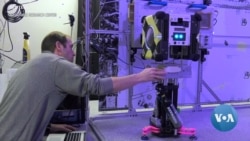ເຖິງແມ່ນພວກທ່ານຈະເຄີຍໄດ້ຍິນ ກ່ຽວກັບວ່າ ມະນຸດເຮົາຈະຍ້າຍໄປຢູ່ ໃນອະວະ
ກາດເປັນການຖາວອນກໍຕາມ ແຕ່ເທົ້າທີ່ຜ່ານມາ ກໍໄດ້ມີແຕ່ພຽງສາມ ຄົນຂຶ້ນໄປຢູ່
ໃນອະວະກາດ. ພວກເຂົາເຈົ້າໄປປະຈຳຢູ່ສະຖານີອະວະກາດນາໆ ຊາດ ແລະກໍໄດ້
ເຮັດວຽກຢູ່ຕະຫລອດ ບໍ່ໄດ້ຢູ່ໄດ້ເຊົາ. ແຕ່ຫວ່າງບໍ່ດົນນີ້ ພວກ ເຫຼົ່ານັ້ນ ໄດ້ຮັບຄວາມ
ຊ່ອຍເຫລືອຈາກຫຸ່ນຍົນ ທີ່ອົງການ ນາຊາ ໄດ້ມອບໃຫ້ ດັ່ງເຄວິນ ອີນິກສ໌ ນັກຂ່າວ
ວີໂອເອ ສົ່ງລາຍງານມາ ຊຶ່ງສາລີຈະນຳລາຍລະ ອຽດມາສະເໜີທ່ານ ໃນອັນດັບຕໍ່ໄປ.
ນີ້ແມ່ນ ອັສໂຕຣບີ (Astrobees) ຊຶ່ງປັດຈຸບັນ ມີສາມໂຕດ້ວຍກັນ ຊື່ວ່າ ຮັນນີ ຄວີນ ແລະບຳເບິລ.
ເມື່ອມໍ່ໆມານີ້ ສອງໂຕໃນຈຳນວນດັ່ງກ່າວ ໄດ້ໄປເຖິງອະວະກາດ ແລະອີກບໍ່ ດົນກໍຈະ
ໄດ້ເປັນພາກສ່ວນນຶ່ງ ຂອງທີມງານ ຂອງສະຖານີອະວະກາດສາກົນ ດັ່ງທີ່ ມາເຣຍ
ບົວລາດ ຜູ້ກຳກັບໂຄງການ ອັສໂຕຣບີ ເວົ້າວ່າ:
“ເວົ້າແລ້ວກໍແມ່ນວ່າ ພວກເຮົາມີ ຫຸ່ນຍົນສອງໂຕ ຄື ຮັນນີ ກັບ ບຳເບິລ ຊຶ່ງ ປັດຈຸບັນ
ກຳລັງເວີ່ນອ້ອມຈັກກະວານຢູ່ ແລະເມື່ອອາທິດແລ້ວນີ້ ພວກເຮົາໄດ້ ກວດກາເບິ່ງ
ເປັນເທື່ອທຳອິດ ບ່ອນທີ່ ແອນ ມັກເຄລນ ນັກອະວະກາດຄົນນຶ່ງ ທີ່ກຳລັງເດີນທາງ
ອ້ອມໂລກຢູ່ໄດ້ໄປໄຂຫີບຫໍ່ ແລ້ວເປີດໄຟ ແລະກວດກາເບິ່ງ ບຳເບິລ. ບຳເບິລ ຍັງມີ
ຊີວິດຢູ່ ແລະມີສຸຂະພາບດີ.
ພວກເຂົາເຈົ້າ ຈະໄປເຮັດວຽກແທນ ສະເຟຍ ຊຶ່ງເປັນຫຸ່ນຍົນໃນເມື່ອກ່ອນ ທີ່ໄປຊ່ອຍ
ຢູ່ກັບ ໄອແອັສແອັສ.
ພວກ ແອັສໂຕຣບີ ມີກ້ອງຖ່າຍຮູບ ແລະໄມໂກຣໂຟນໄປພ້ອມ ແລະໃນລະ ຫວ່າງ
ສອງສາມເດືອນຂ້າງໜ້ານີ້ ຜູ້ກຳກັບໂຄງການ ມາເຣຍ ບົວລາດ ກ່າວວ່າ ພວກເຂົາ
ເຈົ້າ ຈະໄດ້ຮຽນຮູ້ຫົນທາງຂອງເຂົາເຈົ້າ ເພື່ອບິນອ້ອມ ໄອແອັສແອັສ ຊຶ່ງທ່ານນາງ
ມາເຣຍເວົ້າວ່າ:
“ພວກເຮົາຈະເອົາກ້ອງຖ່າຍໄປປະກອບໃສ່ໄວ້ ທັງຈະໃຫ້ມີການແຕ້ມແຜນທີ່ໄປ
ພ້ອມ ຢູ່ບ່ອນທີ່ນັກເຫາະອະວະກາດ ຈະສາມາດນຳເອົາຫຸ່ນຍົນ ບິນເຂົ້າອອກ ໄປ
ມາ ຂ້າມຫຸ່ນທົດລອງຂອງຍີ່ປຸ່ນ ເພື່ອຮິບໂຮມເອົາຮູບພາບຂໍ້ມູນ ຊຶ່ງເຮົາຈະ ນຳມາ
ໃຊ້ ເພື່ອແຕ້ມແຜນທີ່ ແຈມ ຫລື ຫຸ່ນທົດລອງຂອງຍີ່ປຸ່ນ.
ເວລາພວກເຂົາເຈົ້າ ໄດ້ມີແຜນທີ່ຢູ່ໃນຕົວແລ້ວ ພວກ ແອັສໂຕຣບີ ກໍຈະສາ ມາດຮູ້
ຈັກຫົນທາງເດີນອ້ອມ ໄອແອັສແອັສ ດ້ວຍຕົນເອງ ທັງຈະເລີ້ມຍົກສິ່ງ ຂອງໜັກໆບາງ
ຢ່າງໄດ້.
ທ່ານນາງ ມາເຣຍ ບົວລາດ ກ່າວຕ່ືມວ່າ:
“ພວກເຮົາຈະໃຫ້ຫຸ່ນຍົນພວກນີ້ ໄດ້ກາຍເປັນມ້າອອກແຮງງານ. ພວກເຮົາຢາກ ໃຫ້
ນັກອະວະກາດ ໄດ້ປະຢັດເວລາ ເພື່ອໃຫ້ພວກນັກເຫາະອະວະກາດໄດ້ເຮັດ ແຕ່ສິ່ງ
ທີ່ມີແຕ່ມະນຸດເຮົາເທົ້ານັ້ນ ເຮັດໄດ້. ແລະມີການເວົ້າກັນວ່າ ໃນວຽກງານ ທົ່ວໄປຂອງ
ຫຸ່ນຍົນ ແມ່ນສາມມິຕິ ວຽກງານຂີ້ດຽດທີ່ເປັນອັນຕະລາຍ ແລະໜ້າ ເບື່ອ. ແມ່ນແລ້ວ ນັ້ນແມ່ນສິ່ງທີ່ເຈົ້າຢາກໃຫ້ຫຸ່ນຍົນເຮັດ ແທນທີ່ຈະໃຫ້ມະນຸດ ເຮົາເຮັດ.”
ນອກນັ້ນ ກໍຍັງມີການທົດລອງອີກຫລາຍຢ່າງ ທີ່ຈະໃຫ້ແອັສໂຕຣບີ ເຮັດ ແລະ ຢູ່ໃນ
ໂຮງຮຽນມັດທະຍົມຊັ້ນກາງ ແລະມັດທະຍົມສົມບູນ ພວກນັກຮຽນຢູ່ທົ່ວປະ ເທດ ກໍ
ແມ່ນໄດ້ແຂ່ງຂັນກັນແລ້ວ ໃນເລື້ອງການທົດລອງ ຂອງເຂົາເຈົ້າບາງ ຢ່າງ.
ພວກແອັສໂຕຣບີ ໄດ້ຖືກປະກອບເຂົ້າກັນແລ້ວ ແລະດາວທຽມທີ່ມີປະຕູນ້ອຍໆ ກໍຈະ
ເລີ້ມອອກເດີນທາງເທື່ອທຳອິດ ໃນເດືອນມິຖຸນາທີ່ຈະມາເຖິງນີ້.
Even though you hear a lot about human beings moving into space permanently, there are really only three humans in space at any give time. They are on the International Space Station and they are very, very busy . But they just got some robotic help from NASA. VOA's Kevin Enochs reports.
These are the Astrobees, currently there are three of them, named Honey, Queen and Bumble.
Two of them recently arrived in space and will soon be a part of the crew of the International Space Station.
Maria Bualat, Astrobee Project Manager
"So we have two robots Honey and Bumble are now on orbit and just last week we had our first checkout activity where Ann Mclean, one of the astronauts on orbit, unpacked and turned on and checked out Bumble, so Bumble is alive and well."
They are taking over from the Spheres, which were an earlier form of robot helpers on the ISS.
The Astrobees have cameras and microphones on board and during the next few months project manager Maria Bualat says they will be learning their way around the ISS.
Maria Bualat, Astrobee Project Manager
"We are going to calibrate the cameras on board and do a mapping activity where the astronaut will manually fly the robot back and forth across the Japanese experiment model to collect imagery data, which we will use to build a map of the JEM, the Japanese experiment module.
Once they have an internal map the Astrobees will be able to find their way around the ISS on their own and begin doing some heavy lifting.
Maria Bualat, Astrobee Project Manager
"We want to turn these into work horses. We want to free up astronaut time to let the crew do things that only humans can do. And there is a saying in robotics in general, ' the 3 D's, dirty dangerous and dull,' right those are the things that you want a robot to do rather than have a human do.
The Astrobee also has a lot of room for experiments, and Middle and High Schoolers around the country are already competing to get some of their experiments on board.
The Astrobees docking module has already been installed and the tiny indoor satellites will begin making their first voyages sometime in June.





